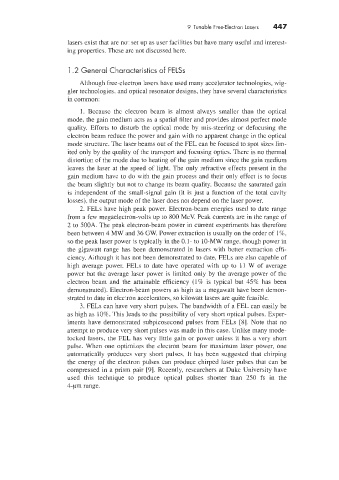Page 487 - Tunable Lasers Handbook
P. 487
9 Tunable Free-Electron Lasers 447
lasers exist that are not set up as user facilities but have many useful and interest-
ing properties. These are not discussed here.
7.2 General Characteristics of FELSs
Although free-electron lasers have used many accelerator technologies, wig-
gler technologies. and optical resonator designs, they have several characteristics
in common:
1. Because the electron beam is almost always smaller than the optical
mode. the gain medium acts as a spatial filter and provides almost perfect mode
quality. Efforts to disturb the optical mode by mis-steering or defocusing the
electron beam reduce the power and gain with no apparent change in the optical
mode struciure. The laser beams out of the FEL can be focused to spot sizes lirn-
ited only by the quality of the transport and focusing optics. There is no thermal
distortion of the mode due to heating of the gain medium since the gain medium
leaves the laser at the speed of light. The only refractive effects present in the
gain medium have to do with the gain process and their only effect is to focus
the beam slightly but not to change its beam quality. Because the saturated gain
is independent of the small-signal gain (it is just a function of the total cavity
losses), the output mode of the laser does not depend on the laser power.
2, FELs have high peak power. Electron-beam energies used to date range
from a few megaelectron-volts up to SO0 MeV. Peak currents are in the range of
2 to 500A. The peak electron-beam power in current experiments has therefore
been between 4 MW and 36 GW. Power extraction is usually on the order of 1%.
so the peak laser power is typically in the 0.1- to 10-MW range, though power in
the gigawatt range has been demonstrated in lasers with better extraction effi-
ciency. 43though it has not been demonstrated to date, FELs are adso capable of
high average power. FELs to date have operated with up to 11 W of average
power but the average laser power is limited only by the average power of the
electron beam and the attainable efficiency (155 is typical but 45% has been
demonstrated). Electron-beam powers as high as a megawatt have been dernon-
strated to date in electron accelerators, so kilowatt lasers are quite feasible.
3. FELs can have very short pulses. The bandwidth of a FEL can easily be
as high as lo%,. This leads to the possibility of very short optical pulses. Exper-
iments have demonstrated subpicosecond pulses from FELs [8]. Note that 110
attempt to produce very short pulses was made in this case. Unlike many mode-
locked lasers, the FEL has very little gain or power unless it has a very short
pulse. When one optimizes the electron beam for maximum laser power, one
automatically produces very short pulses. It has been suggested that chirping
the energy of the electron pulses can produce chirped laser pulses that can be
compressed in a prism pair [9]. Recently, researchers at Duke University have
used this technique to produce optical pulses shorter than 250 fs in the
4-pm range.

